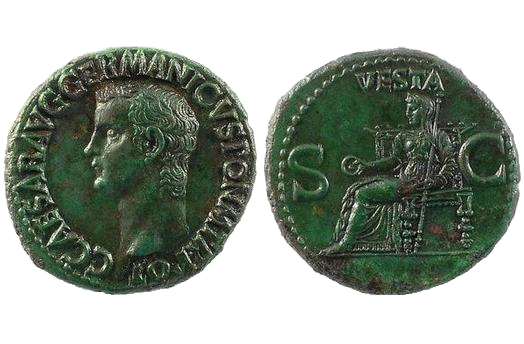
about ancient nomos
Ancient Nomos Art is a museum of galleries exhibiting ancient coins and ancient mint maps. The coin gallery displays the diverse art and history of hand-crafted ancient Greek, Roman, Byzantine, Persian and Medieval coinage. The ancient mints mapping gallery features Greek, Roman, Byzantine, Asia Minor and Medieval mint city regions and territories. Visitor's are welcome to explore, study and enjoy Ancient Nomos Art.

Imperial, Rome – 37 AD
Gaius Caligula
From Ancient Galleries

Obverse: Bare head bust of Gaius Julius Caesar Germanicus "Caligula" facing left.
Reverse: Vesta seated on ornate high-back throne holding patera in right hand.
LEGEND
Obv: C • CAESAR • AVG • GERMANICVS • PON • M • TR • POT, Bust of Caligula facing left with bare head. Rev: VESTA above, S C across field. Vesta, veiled and draped, seated left on ornate high-backed throne, holding patera in extended right hand and transverse scepter in left.
Emperor Caligula, named Gaius Julius Caesar Germanicus, was born in 12 AD. He was nicknamed Caligula as a youth for having been frequently seen wearing his “caligae” soldier boots. He was the youngest son of General Germanicus and the nephew of Emperor Tiberius and Agrippina. Caligula was educated in the Antium and was later invited by Tiberius in 31 AD to live with him in Capraea, shortly after he avoided the violent deaths that befell his brothers Nero, Drusus and Praetorian Guard, Sejanus. Tiberius died in 37 AD by an illness, aided by an apparent suffocation by Caligula. After the Emperor’s death, Caligula marched into Rome and forced the Senate to join in Senatus Consultum. The large S C abbreviation on the coins reverse signifies Caligula’s Senatus Consultum, meaning “as decreed by the Senate, with power as law,” thus declaring him the new Emperor. The coins obverse depicts Caligula bare head and facing left, clean shaven, with deep set eyes, pursed lips and weak chin. This portrait style is similar in appearance to the busts from his Julio-Claudian ancestry, with noticeably fewer patrician features and a more pernicious expression. Struck during Caligula’s first year as Emperor, the coins legend demonstrates how he tries to legitimize his new reign with a bit of ancestral propaganda (J Key). The legend honors his father’s name GERMANICVS, following the titles CAESAR and AVGustus, thus attempting to link a direct heritage to Rome’s first Emperor Augustus. The reverse depicts the goddess Vesta (Greek Hestia), enthroned in an ornate, high back chair holding her patera and scepter. Her seated cult statue was likely on display in the round marble remains of the Temple of Vesta in the Forum Romanum. She was the goddess of hearth, home, family, and provider of the eternal flame for sacrificial fires, aided by her six Vestal Virgins.
DOCUMENTATION
Value: Aes. Metal: Æ Bronze. Weight: 11.00 grams. Mint: Rome. Date: 37-38 AD.
Attribution: Roman Imperial Coins I 38; BMCRE 46-48; RCTV 1803; BN 54-71; Cohen 27.
Legend, Documentation and Attribution
